GIRAFFE
Giraffe camelopardalis

Name: Giraffe
Scientific name: Giraffa camelopardalis
Range: Africa
Habitat: Dry, tree-scattered terrain south of the Saraha
Status: Not threatened
Diet: Acacia tree leaves, grass, and low laying bushes
Diet in the Zoo: Herbivore diet
Location in the Zoo: African
Savannah
Physical description:
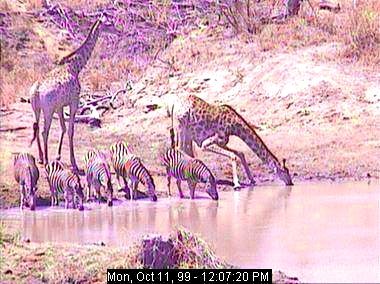
Average male height 17 feet (5.3 meters), Weight averages 1800 pounds
(800 kg). The hoofed animals have chestnut brown blotches on buff
colored fur. The spots on the fur darken as the animal ages.
Giraffes have very long, flexible tongues and lips to go along with their
long slender necks. The male giraffe's neck continues to grow after sexual
maturity has been reached, whereas the females' neck stops growing when
maturity is reached at about 10 years of age. Giraffes have seven vertebrae
in their necks, just as humans do. They have very large eyes on the sides
of their head, atop a periscope like neck, that give them wonderful eyesight.
Also on the top of their head, they carry 2-4 stubby horns that lie under
the skin. Their 8 inch ears give them a good sense of hearing.
The size of these giraffes can really be appreciated
when
seen next to these zebras. Photo courtesy of
Africam
General information:
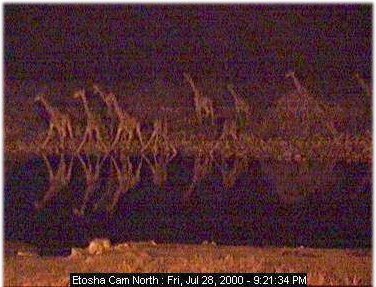 Giraffes
tend to travel in herds that vary from as few as 3 to as many as 15 in
number. The females tend to stick together in family groups while
they lose some of their young males to all-bachelor groups. These
herds may separate to graze for the day, but they always stay within hearing
and vision range of each other. A large male may consume up to 75
pounds of food every 24 hours. Their stomach is like a cow's stomach,
having four chambers that require the animal to chew its cud, fist sized
balls of unchewed food that are regurgitated. These animals are thought
to be very intelligent.
Giraffes
tend to travel in herds that vary from as few as 3 to as many as 15 in
number. The females tend to stick together in family groups while
they lose some of their young males to all-bachelor groups. These
herds may separate to graze for the day, but they always stay within hearing
and vision range of each other. A large male may consume up to 75
pounds of food every 24 hours. Their stomach is like a cow's stomach,
having four chambers that require the animal to chew its cud, fist sized
balls of unchewed food that are regurgitated. These animals are thought
to be very intelligent.
Giraffe herd passing a water hole at
night
courtesy of Africam
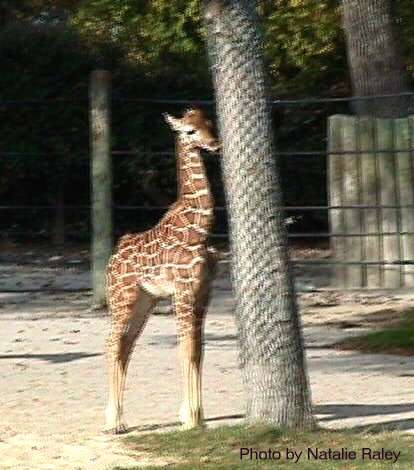 The
birth of a giraffe is the most dangerous time in its life. Almost
half of all newborns are killed by predators within the first few minutes.
A newborn calf, weighing between 120-150 pounds and standing 6 feet tall,
usually stands within several minutes and begins nursing within an hour.
The mother hides her calf for the first month trying to keep it safe from
predators. Affection and protection is shown by the mother by rubbing,
touching, sniffing, and licking her baby. The calves begin playing
in "nursery" groups at about 2 months of age, learning necessary survival
skills.
The
birth of a giraffe is the most dangerous time in its life. Almost
half of all newborns are killed by predators within the first few minutes.
A newborn calf, weighing between 120-150 pounds and standing 6 feet tall,
usually stands within several minutes and begins nursing within an hour.
The mother hides her calf for the first month trying to keep it safe from
predators. Affection and protection is shown by the mother by rubbing,
touching, sniffing, and licking her baby. The calves begin playing
in "nursery" groups at about 2 months of age, learning necessary survival
skills.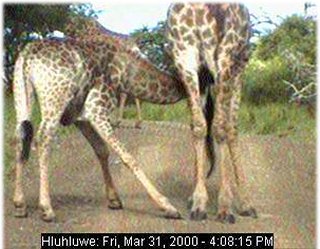
Young giraffe nursing
courtesy of Africam
Special anatomical, physiological or behavioral
adaptations.
 The
long muscular necks were once thought to be explained by Darwin's Natural
Selection theory, but are now said to have come about by sexual selection.
The male giraffes use their neck and head to battle for a female in estrous.
The weight of the weapon, the head, produces great momentum when being
swung at the chest, ribs, legs and neck of their opponent. This act, called
"necking", can cause great injury and even death. At one zoo in North America,
a keeper accidentally allowed two males to get into the same pen with a
female in heat. The smaller male was killed when his opponent punched a
hole in his neck just below the ear, splintering a vertebrate and penetrating
the spinal column. Experts seem to think that, because of this necking
behavior, giraffes evolved through sexual selection. This also explains
the fact that these animals spend 50 percent of their time grazing at bushes
below their shoulder.
The
long muscular necks were once thought to be explained by Darwin's Natural
Selection theory, but are now said to have come about by sexual selection.
The male giraffes use their neck and head to battle for a female in estrous.
The weight of the weapon, the head, produces great momentum when being
swung at the chest, ribs, legs and neck of their opponent. This act, called
"necking", can cause great injury and even death. At one zoo in North America,
a keeper accidentally allowed two males to get into the same pen with a
female in heat. The smaller male was killed when his opponent punched a
hole in his neck just below the ear, splintering a vertebrate and penetrating
the spinal column. Experts seem to think that, because of this necking
behavior, giraffes evolved through sexual selection. This also explains
the fact that these animals spend 50 percent of their time grazing at bushes
below their shoulder.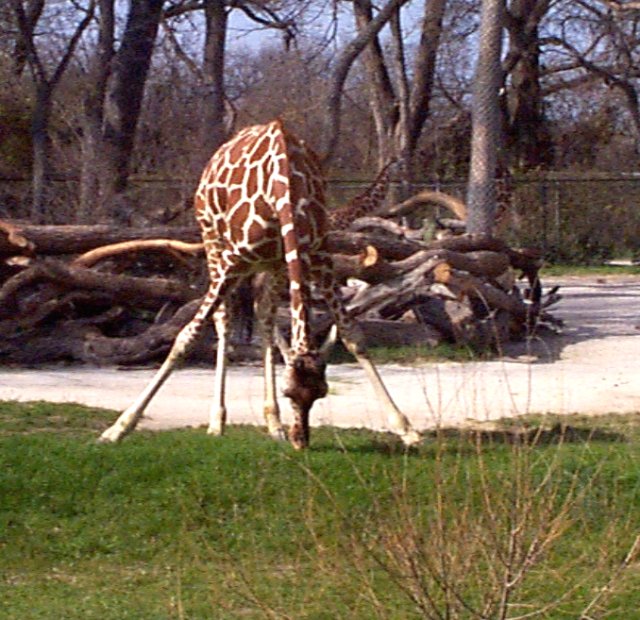
Comments about the giraffes of the Fort Worth Zoo:
The attendants were out when I was able to go to the zoo on November
24. I will go again as soon as I have the time and money so that
I can tell of the individual animals.
(even if it is after semester)
Personal Observations:
The giraffes seemed very curious as to what we were doing and taking
pictures of. They seemed to want to be looked at and payed attention
to. The baby giraffe was licking a tree while under the protection
of his mother. They are majestic, graceful creatures that I received
amazment from watching.
Related links:
http://nature-wildlife.com/gir0.html
http://planet-pets.com/plntgraf.htm
http://www.personal.psu.edu/users/m/r/mrp141/camel.html
http://home.pacbell.net/davelars/emily/giraffes.htm
Page Author:
Natalie Raley
Send e-mail to:
LilPetDr@aol.com
or to
mac@whozoo.org
Source list:
Simmons, Robert E. and Lue Scheepers. "Winning by
a Neck: Sexual Selection in the Evolution of Giraffe."
The American Naturalist Nov 96: 771-86.
Chutes and Landers. "How the Giraffe got its Neck." Discover
March 96: 14.
Encarta Encyclopedia on CD ROM.


 Giraffes
tend to travel in herds that vary from as few as 3 to as many as 15 in
number. The females tend to stick together in family groups while
they lose some of their young males to all-bachelor groups. These
herds may separate to graze for the day, but they always stay within hearing
and vision range of each other. A large male may consume up to 75
pounds of food every 24 hours. Their stomach is like a cow's stomach,
having four chambers that require the animal to chew its cud, fist sized
balls of unchewed food that are regurgitated. These animals are thought
to be very intelligent.
Giraffes
tend to travel in herds that vary from as few as 3 to as many as 15 in
number. The females tend to stick together in family groups while
they lose some of their young males to all-bachelor groups. These
herds may separate to graze for the day, but they always stay within hearing
and vision range of each other. A large male may consume up to 75
pounds of food every 24 hours. Their stomach is like a cow's stomach,
having four chambers that require the animal to chew its cud, fist sized
balls of unchewed food that are regurgitated. These animals are thought
to be very intelligent.

